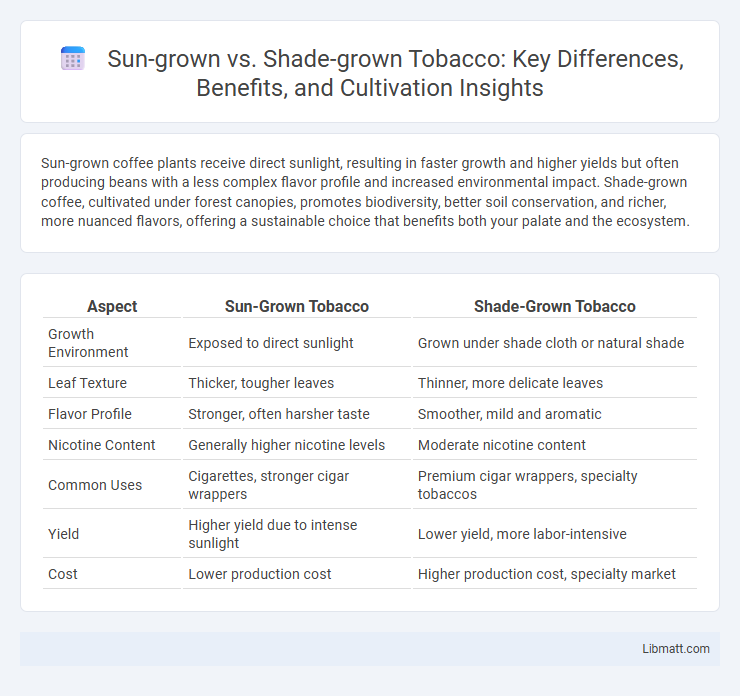Sun-grown coffee plants receive direct sunlight, resulting in faster growth and higher yields but often producing beans with a less complex flavor profile and increased environmental impact. Shade-grown coffee, cultivated under forest canopies, promotes biodiversity, better soil conservation, and richer, more nuanced flavors, offering a sustainable choice that benefits both your palate and the ecosystem.
Table of Comparison
| Aspect | Sun-Grown Tobacco | Shade-Grown Tobacco |
|---|---|---|
| Growth Environment | Exposed to direct sunlight | Grown under shade cloth or natural shade |
| Leaf Texture | Thicker, tougher leaves | Thinner, more delicate leaves |
| Flavor Profile | Stronger, often harsher taste | Smoother, mild and aromatic |
| Nicotine Content | Generally higher nicotine levels | Moderate nicotine content |
| Common Uses | Cigarettes, stronger cigar wrappers | Premium cigar wrappers, specialty tobaccos |
| Yield | Higher yield due to intense sunlight | Lower yield, more labor-intensive |
| Cost | Lower production cost | Higher production cost, specialty market |
Introduction to Sun-Grown vs Shade-Grown
Sun-grown coffee is cultivated in open fields with direct sunlight, resulting in faster plant growth and higher yields but often lower flavor complexity. Shade-grown coffee grows under a canopy of trees, promoting biodiversity and slower bean maturation that enhances nuanced flavors and environmental sustainability. The choice between sun-grown and shade-grown impacts coffee quality, ecosystem health, and farming practices.
Defining Sun-Grown and Shade-Grown Methods
Sun-grown coffee is cultivated in open fields exposed to direct sunlight, promoting faster growth and higher yields but often leading to lower biodiversity. Shade-grown coffee thrives under a canopy of trees, enhancing ecosystem health and supporting bird populations while typically producing beans with more complex flavors. Understanding these methods helps you choose coffee that aligns with your environmental and taste preferences.
Environmental Impacts of Sun vs Shade Cultivation
Sun-grown cultivation typically demands extensive deforestation, resulting in habitat loss, reduced biodiversity, and increased carbon emissions. Shade-grown methods promote a more sustainable environment by preserving native tree cover, supporting diverse ecosystems, and enhancing soil health. Your choice of shade-grown products directly contributes to conserving wildlife habitats and mitigating climate change effects.
Effects on Crop Yield and Quality
Sun-grown coffee typically produces higher crop yields due to increased photosynthesis, but may compromise bean quality by exposing plants to stress and faster ripening. Shade-grown coffee often results in lower yields yet enhances bean quality by promoting slower, more even maturation, which develops complex flavors and acidity. Your choice between sun-grown and shade-grown methods impacts both the volume and flavor profile of the coffee harvest.
Flavor and Aroma Differences
Sun-grown coffee beans develop a bolder, more robust flavor with higher acidity and a brighter taste profile, while shade-grown beans tend to offer a smoother, more complex flavor with subtle sweetness and enhanced aromatic nuances. The slower maturation of shade-grown coffee allows for greater depth in aroma, often featuring floral, fruity, and earthy notes that are less pronounced in sun-grown varieties. Your choice between sun-grown and shade-grown coffee directly influences the balance between intensity and complexity in flavor and aroma, catering to different palate preferences.
Biodiversity and Ecosystem Benefits
Shade-grown coffee supports higher biodiversity by providing habitat for numerous bird species, insects, and plants, enhancing local ecosystem health. Sun-grown coffee often requires clearing native vegetation, reducing habitat complexity and leading to soil degradation and lower ecosystem resilience. Choosing shade-grown practices helps maintain ecological balance and protects your environment's rich biodiversity.
Economic Considerations for Farmers
Sun-grown coffee often offers higher immediate yields and lower labor costs, making it economically attractive for farmers seeking quick returns. Shade-grown coffee typically commands premium prices due to its environmental benefits and superior flavor but involves more labor-intensive practices and potentially lower output. Your decision should balance yield potential, market demand, and long-term sustainability to maximize profitability.
Consumer Preferences and Market Trends
Consumer preferences increasingly favor shade-grown coffee due to its environmentally sustainable practices and richer flavor profiles, influencing market trends toward organic and ethical sourcing. Sun-grown coffee, while producing higher yields, is often associated with deforestation and lower biodiversity, leading some buyers to seek alternatives that align with their values. Your choice in coffee reflects a growing market shift emphasizing quality, sustainability, and social responsibility.
Sustainability of Sun-Grown and Shade-Grown Practices
Sun-grown coffee cultivation often leads to higher yields but contributes to deforestation, soil erosion, and loss of biodiversity, posing significant sustainability challenges. In contrast, shade-grown practices promote ecological balance by preserving tree cover, enhancing soil health, and supporting wildlife habitats, making them a more sustainable alternative. Sustainable coffee farming increasingly favors shade-grown methods to reduce environmental impact and maintain ecosystem services.
Conclusion: Choosing the Optimal Method
Sun-grown coffee offers higher yield and faster development, making it suitable for large-scale commercial production. Shade-grown coffee supports greater biodiversity and richer flavor profiles, appealing to environmentally conscious consumers and specialty markets. Selecting the optimal method depends on balancing economic goals with environmental sustainability and quality preferences.
Sun-grown vs Shade-grown Infographic

 libmatt.com
libmatt.com